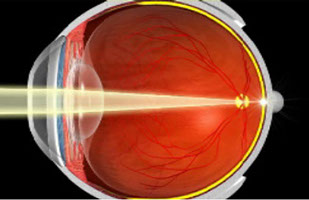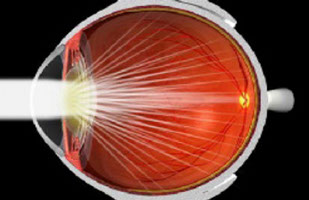EYES
KNOW YOUR
Cataract
A patient with cataract will eventually find it hard to read, or drive a car - especially during the night. Even recognizing people's face and seeing expressions becomes difficult. Cataracts are not usually painful. The patient’s long distance vision is more affected initially.
Cataract developes in the lens; the lens become cloudy inside the eye - which is normally clear. Cataracts can develop in one or both eyes. If they develop in both eyes, one will be more severely affected than the other. A clear lens allows light to pass through to the back of the eye, so that the patient can see well-defined images.
If a part of the lens becomes opaque light does not pass through easily and the patient's vision becomes blurry - like looking through cloudy water or a fogged-up window. The more opaque (cloudier) the lens becomes, the worse the person's vision will be.
As cataracts develop very slowly most people do not know they have them at first. However, the clouding progresses and vision will gradually get worse. Stronger lighting and eyeglasses can help improve vision.
Nevertheless, the vision impairment affects the patient’s ability to carry out everyday tasks. At this point the individual will need surgery. Fortunately, cataract surgery is usually a very effective and safe procedure.
Introduction

Figure : Eye with clear lens & Eye with cataract
Signs & Symptoms
(i) Age related cataracts - they appear later in life; the most common form
(ii) Congenital cataracts (childhood cataracts)
These may be present when the baby is born, or shortly after birth. Cataracts may also be diagnosed in older
babies and children - these are sometimes referred to as developmental, infantile or juvenile cataracts


Figure : Eye with clear lens
Figure : Eye with cataract


Figure : Normal vision
Figure : Vision with cataract
Cataract Surgery
The cloudy lens is removed from the eye and an artificial clear plastic lens is put in its place - an intraocular implant (intraocular lens).
In most developed countries, and a growing number of developing countries, cataract operations are performed as keyhole surgery. The patient will be given a local anesthetic. He/she will not usually have to spend the night in hospital.
The operation is commonly known as phacoemulsification or phaco extracapsular extraction. Laser surgery is not used for cataract procedures.
Micro Incision Cataract Surgery (MICS)
Micro Incision Cataract Surgery (MICS) is the most advanced, state of the art surgical technique for treating cataracts. Now only tiny incision measuring 1.80-2.00mm is required to perform the surgery. Using a technique called phacoemulsification, an ultrasound probe is used to safely breakup the cataract. The cataract is then removed with suction and the intraocular lens (IOL) is then inserted into the eye through a 1.81 mm incision. The whole procedure takes approximately 20-30 minutes.

The benefit of MICS:
1. Micro Incision (Smaller Incision)
► Smaller incision of 1.80-2.00mm can prevent unwanted interferences to vision known as astigmatism.
(The larger incision used for standard cataract surgery may cause unwanted changes to the eye, known as
surgically induced astigmatism)
2. Less Pain
► Less invasive, a more gentle surgery providing the best comfort
3. Faster Healing
► Faster healing and recovery time, thus decreasing the chances of infection
LOCATION
Ipoh
23-27 Jalan Kamaruddin Isa
(Jalan Fair Park)
31400 Ipoh Perak
Malaysia
Taiping
27 Jalan Medan Taiping 5
Taman Medan Taiping
34000 Taiping Perak
Malaysia
CONSULTATION HOURS
Ipoh
Mon., Tue. & Fri. : 2.00 pm - 5.00 pm
Wed. & Thurs : 9.00 am - 1.00 pm
Sat. : 9.00 am - 12.00 pm
Taiping
Monday : 8.30 am - 1.00 pm
Wednesday : 2.00 pm - 4.00 pm
Saturday : 2.30 pm - 6.00 pm
© 2014 All Right Reserved, Chew Eye Specialist & Surgery Sdn. Bhd.
